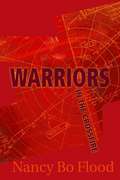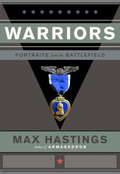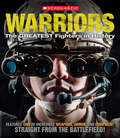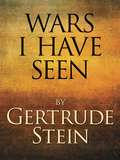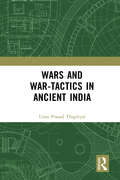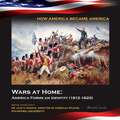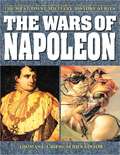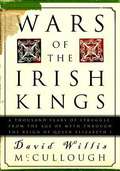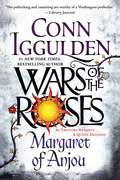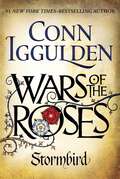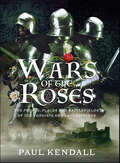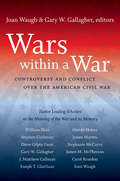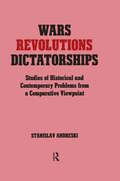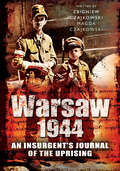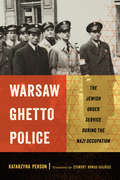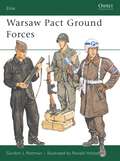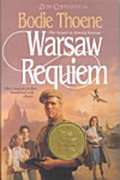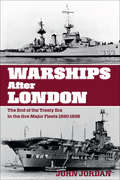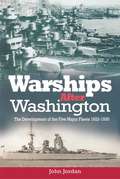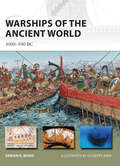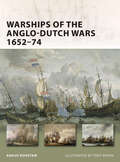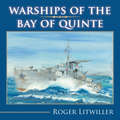- Table View
- List View
Warriors: In the Crossfire
by Nancy Bo FloodIn the South Pacific during World War II, Joseph takes responsibility for his people. On the island of Saipan, the war is a distant idea for Joseph.
Warriors: Portraits from the Battlefield
by Max HastingsHeroism in battle has been celebrated throughout history, yet it is one of the least understood virtues. What makes some men and women perform extraordinary deeds on the battlefield? What makes them risk their lives in the pursuit of victory? Max Hastings, one of our foremost military historians, has seen combat up close and written about it for decades. In Warriors, he brings us the experiences of fourteen soldiers who fought in the wars of the nineteenth and twentieth centuries. From an exuberant cavalry officer in Napoleon's army to an abused orphan who in World War II became America's youngest general since Custer, to an Israeli officer who recovered from a devastating injury to save his country, each portrait depicts a unique and remarkable story. A tribute to soldierly valor and a deeply insightful study of combat, this is an essential book for anyone who wishes to understand what it means to be at war.
Warriors: The Greatest Fighters In History (Reference Non-fiction (scholastic Inc) Ser.)
by Sean CalleryThis stunning book about the greatest warriors of all time is packed with facts, infographics, expert text, and photography from museums and private collections.WARRIORS is a feast of cool visuals--you'll see a wealth of objects and artifacts that will leave you wide-eyed. Explore collections of weapons, armor, uniforms, medals, everyday equipment, and much more. Find out what these objects can show us about battle tactics, key moments in history, and life as a soldier. Meet the most famous warriors of all time. What weapons did ancient Spartan warriors use? How heavy was a knight's armor? What equipment did Civil Warsoldiers rely on? Who were the first warriors to take to the skies? What hi-tech kit gives today's pilots the edge?WARRIORS uses hundreds of images along with fact-packed infographics and expert text topresent important and unique information that holds kids' attention and appeals to their desire to collect amazing facts. Now in ebook!
Wars I Have Seen: Gertrude Stein Collection
by Gertrude SteinWars I Have Seen is the American writer Gertrude Stein's memoir of her experiences during the Second World War. Gertrude Stein was living in Europe during the time of the war.
Wars and Rumors of Wars
by Roger Lincoln ShinnReflections on wars by a noted professor of Christian ethics. The book includes an autobiographical fragment describing his captivity by the Germans in 1944-45.
Wars and War-Tactics in Ancient India
by Uma Prasad ThapliyalThis work discusses the wars fought in ancient India and the war strategies that came to be developed. Advanced modes of combat were devised and new methods related to the use of various weapons were perfected. The volume also delves into The Mahābhārata and works like the Arthaśāstra, the Kāmandakīy Nītisāra and the Śukranīti that contain graphic descriptions of war tactics as these evolved over the centuries. Please note: Taylor & Francis does not sell or distribute the Hardback in India, Pakistan, Nepal, Bhutan, Bangladesh and Sri Lanka.
Wars at Home: America Forms an Identity (1812-1820) (How America Became America)
by Michelle QuinbyBy the beginning of the 1800s, America was a young country led by people who were ready to fight to defend American rights on the seas and at home. They were eager to teach Europe's older nations a lesson, and they wanted to add to America's land. America fought the War of 1812 as well as a war in Florida. The US came out of these wars stronger than ever-- and the people of the United States were ready for America to grow still bigger.
Wars of Napoleon
by Albert Sidney BrittThis fascinating study takes the reader from the early years of Napoleon's career to his defeat at Waterloo. It is a penetrating look at the technology, tactics, logistics, strategy, and outstanding generalship that created an empire.
Wars of the Irish Kings: A Thousand Years of Struggle from the Age of Myth Through the Reign of Queen Elizabeth I
by David Willis McculloughFor the first thousand years of its history, Ireland was shaped by its monasteries and its wars. The artistic flourishing of the monasteries has received a good deal of attention, but the violent and varied wars have in recent years gone unremembered. In Wars of the Irish Kings, David Willis McCullough has turned back to the earliest accounts of these struggles to present a rich tapestry of Ireland's fight for its identity. Beginning with the legends of ancient wars and warriors, moving through a time when history and storytelling were not separate crafts, into a time when history was as much propaganda as fact, Wars of the Irish Kings tells of tribal battles, foreign invasions, Viking raids, family feuds, wars between rival Irish kingdoms, and wars of rebellion against the English. This collection is peopled with familiar names: Cuchulain, Finn MacCool, Brian Boru, Mad King Sweeney, Strongbow, Edward and Robert Bruce, Queen Elizabeth I and Lord Essex, Hugh O'Donnell, and Hugh O'Neill. Battles formed the legends and history of the land: the Da Dannan meet the Fir Bolgs near Sligo, Brian Boru faces the Vikings at Clontarf in Dublin Bay, High King Rory O'Connor confronts the English invaders near Waterford, O'Briens battle the English (and other O'Briens) at Dysert O'Dea near Limerick, guns are carried for the first time in battle at Knockdoe near Galway, the Bruces from Scotland and their Irish allies overwhelm the English at Connor in Ulster, and Hugh O'Neill ambushes General Bagenal near Armagh. The book ends near Cork in 1601 when the English defeat O'Neill and his Spanish allies at Kinsale. Common people as well as kings appear in these pages. A foot soldier in the early days of gunpowder accidentally sets off a disastrous explosion, a harper's disembodied head is sent by error to the king of England, who displays it as that of the king of Ireland, and a Welsh camp follower named Alice is given the job of executing Irish captives during the English invasion. The sources for these stories and many more range from ancient manuscripts telling of mythical battles to a seventeenth-century siege diary. There are excerpts from such Irish literary masterpieces as The Cattle Raid of Cooley (The Tain), the monumental Annals of the Four Masters, passages from Gerald of Wales's account of the English conquest in the twelfth century, pages from an Icelandic saga, and even a blistering letter from Queen Elizabeth I to her inept commander in Ireland ("You do but piece up a hollow peace ..."). The result is a surprisingly immediate and stunning portrait of an all-but-forgotten time that forged the Ireland to come.
Wars of the Roses: Bloodline
by Conn IgguldenThe brilliant retelling of the Wars of the Roses continues with Bloodline, the gripping third novel in the new series from historical fiction master Conn Iggulden. Winter 1461: Richard, duke of York, is dead--his ambitions in ruins, his head spiked on the walls of the city. King Henry VI is still held prisoner. His Lancastrian queen, Margaret of Anjou, rides south with an army of victorious northerners, accompanied by painted warriors from the Scottish Highlands. With the death of York, Margaret and her army seem unstoppable. Yet in killing the father, Margaret has unleashed the sons. Edward of March, now duke of York, proclaims himself England's rightful king. Factions form and tear apart as snow falls. Through blood and treason, through broken men and vengeful women, brother shall confront brother, king shall face king. Two men can always claim a crown--but only one can keep it. Following Margaret of Anjou, Bloodline is the third epic installment in master storyteller Conn Iggulden's new Wars of the Roses series. Fans of the Game of Thrones and the Tudors series will be gripped from the word "go."From the Hardcover edition.
Wars of the Roses: Margaret of Anjou
by Conn IgguldenThe brilliant retelling of the Wars of the Roses continues with Margaret of Anjou, the second gripping novel in the new series from historical fiction master Conn Iggulden.As Traitors Advance...A Queen DefendsIt is 1454 and for over a year King Henry VI has remained all but exiled in Windsor Castle, struck down by his illness, his eyes vacant, his mind a blank. His fiercely loyal wife and Queen, Margaret of Anjou, safeguards her husband's interests, hoping that her son Edward will one day come to know his father.With each month that Henry is all but absent as king, Richard, the Duke of York, Protector of the Realm, extends his influence throughout the kingdom. The Trinity--Richard and the earls of Salisbury and Warwick--are a formidable trio, and together they seek to break the support of those who would raise their colors and their armies in the name of Henry and his Queen.But when the king unexpectedly recovers his senses and returns to London to reclaim his throne, the balance of power is once again plunged into turmoil. The clash of the Houses of Lancaster and York may be the beginning of a war that can tear England apart . . .Following on from Stormbird, Margaret of Anjou is the second epic installment in master storyteller Conn Iggulden's new Wars of the Roses series. Fans of Game of Thrones and The Tudors will be gripped from the word "go."
Wars of the Roses: Stormbird (Wars of the Roses #1)
by Conn Iggulden"Capturing the violence and romance of medieval life, Iggulden makes real those grand characters who live in the collective memory. A page-turner sure to have readers eager for the next in the series." --KirkusThe first book in #1 New York Times-bestselling author Conn Iggulden's brilliant new historical series about two families who plunged England into a devastating, decades-long civil war.In 1437, the Lancaster king Henry VI ascends the throne of England after years of semi-peaceful regency. Named "The Lamb," Henry is famed more for his gentle and pious nature than his father's famous battlefield exploits; already, his dependence on his closest men has stirred whispers of weakness at court. A secret truce negotiated with France to trade British territories for a royal bride--Margaret of Anjou--sparks revolts across English territory. The rival royal line, the House of York, sees the chaos brought on by Henry's weakness and with it not only opportunity in the monarch, but also their patriotic duty in ousting an ineffectual king. As storm clouds gather over England, King Henry and his supporters find themselves besieged abroad and at home. Who or what can save the kingdom before it is too late?
Wars of the Roses: The People, Places and Battlefields of the Yorkists and Lancastrians
by Paul KendallThe Wars of the Roses, which saw England and Wales ravaged by warfare for three decades and dynasties rise and fall, decimated the nobility of an entire generation, and saw the rise of the merchant class, the decline of medieval feudalism and opened the country to the enlightened ideals of the Renaissance. Such has been its lasting effects the red and white rose of the Tudors is still a national symbol. This book is an exploration of the buildings, monuments, towns and battlefields of that turbulent era across both England and Wales – places that can still be visited and experienced today. The stories of the great battles of St Albans, Stoke Field, Wakefield, Townton, Barnet, Tewksbury and, of course, Bosworth, are told along with beautiful photographs to help guide the reader round these important sites, as well as the dozens of smaller engagements where the supporters of the Houses of York and Lancaster fought and died. Here are castles and manor houses galore, all of which played their part in this protracted struggle for the throne of England, such as Richard of York’s imposing powerbase of Lulow Castle and the magnificent Tudor stronghold of Bamburg. These are compared with the scant remains of Fotheringhay Castle, the birthplace of Richard III – the man whose remains were so dramatically uncovered in Leicester – and Micklegate Bar, York, was where Richard’s head was placed on a spike. We see the Clocktower of St Albans and ‘Gabriel’ the bell that was rung in 1455 alerting of the Yorkist advance, as well as the Tower of London where Henry VI met his death and the possible burial place of the two princes. These, and scores of other places, monuments, plaques, buildings and battlegrounds, represent not only a journey across England and Wales, but a journey back in time to the bloody conflict that was the War of the Roses.
Wars within a War: Controversy and Conflict over the American Civil War
by Gary W. Gallagher Joan WaughComprised of essays from 12 leading scholars, this volume extends the discussion of Civil War controversies far past the death of the Confederacy in the spring of 1865. Contributors address, among other topics, Walt Whitman's poetry, the handling of the Union and Confederate dead, the treatment of disabled and destitute northern veterans, Ulysses S. Grant's imposing tomb, and Hollywood's long relationship with the Lost Cause narrative. The contributors are William Blair, Stephen Cushman, Drew Gilpin Faust, Gary W. Gallagher, J. Matthew Gallman, Joseph T. Glatthaar, Harold Holzer, James Marten, Stephanie McCurry, James M. McPherson, Carol Reardon, and Joan Waugh.
Wars, Revolutions and Dictatorships: Studies of Historical and Contemporary Problems from a Comparative Viewpoint
by Stanislav AndreskiFirst Published in 1992. Routledge is an imprint of Taylor & Francis, an informa company. We can define war as organised fighting between groups of individuals belonging to the same species but occupying distinct territories, thus distinguishing war from fights between isolated individuals as well as from struggles between groups living intermingled within the same territory, which can be classified as rebellions, revolutions, riots and so on.The articles included in this volume were written in the 1970s and 1980s and published in very diverse journals and proceedings of conferences, in one case only in German.
Warsaw 1944: An Insurgent's Journal of the Uprising
by Zbigniew Czajkowski&“Built around a journal written in the months just after the Warsaw uprising by . . . a teenage fighter in the Polish underground . . . a compelling account.&” —HistoryOfWar.org This remarkable journal, written shortly after the event, describes not only the author&’s own experiences of the 1944 Warsaw Uprising but the wider picture. With the Soviet Army&’s arrival imminent, the Polish Underground fighters decided to wage open warfare against the hated Nazi occupiers. This courageous decision was taken despite the Poles chronic shortage of arms, ammunition, and medical support. They fully expected the Soviets to relieve them gratefully for hastening the defeat of the Germans. With cruel and calculated cynicism, the Soviets halted their offensive and let the uneven match be settled without their involvement. The outcome was inevitable Warsaw was largely destroyed, the Polish men, women, and children fighters crushed and the Nazis weakened. The Soviets then moved in. This journal is a unique record of the bitter fighting when neither side was prepared to give quarter. &“Authentic, dramatically realistic, showing the tragedy of a generation thrown into a hopeless battle. A priceless treasure against which other memoirs pale in comparison.&” —Lech Dzikiewicz &“The author has described the scenes of fighting so vividly almost impossible to believe he had come out unscathed.&” —Kultura &“An exceptionally valuable document—great historical and literary value.&” —Dziennik Polski
Warsaw Ghetto Police: The Jewish Order Service during the Nazi Occupation
by Katarzyna PersonIn Warsaw Ghetto Police, Katarzyna Person shines a spotlight on the lawyers, engineers, young yeshiva graduates, and sons of connected businessmen who, in the autumn of 1940, joined the newly formed Jewish Order Service.Person tracks the everyday life of policemen as their involvement with the horrors of ghetto life gradually increased. Facing and engaging with brutality, corruption, and the degradation and humiliation of their own people, these policemen found it virtually impossible to exercise individual agency. While some saw the Jewish police as fellow victims, others viewed them as a more dangerous threat than the German occupation authorities; both were held responsible for the destruction of a historically important and thriving community. Person emphasizes the complexity of the situation, the policemen's place in the network of social life in the ghetto, and the difficulty behind the choices that they made. By placing the actions of the Jewish Order Service in historical context, she explores both the decisions that its members were forced to make and the consequences of those actions.Featuring testimonies of members of the Jewish Order Service, and of others who could see them as they themselves could not, Warsaw Ghetto Police brings these impossible situations to life. It also demonstrates how a community chooses to remember those whose allegiances did not seem clear.Published in Association with the US Holocaust Memorial Museum.
Warsaw Pact Ground Forces
by Gordon Rottman Ronald VolstadOsprey's study of the ground forces of the Cold War (1946-1991). While much has been published on the armed forces of the USSR during the 1980s, surprisingly little is available on the forces supplied by the other member nations of the Warsaw Pact. Rivalling the size of the United States Army, the combined ground forces of the six non-Soviet Warsaw Pact countries totalled over 775,000 active troops, with almost two million ground forces reserves. This book examines the history, organization and uniforms of the often overlooked DDR, Czechoslovak, Polish, Bulgarian, Hungarian and Romanian forces at the end of the Cold War.
Warsaw Requiem (The Zion Convent #6)
by Bodie Thoene Brock ThoeneThe compelling sequel to Danzig Passage, and the sixth book in the Zion Covenant Series, carrying on the life-and-death struggle to save Jewish children. Having overrun Czechoslavakia, German tanks now storm across the borders of Poland while Nazi planes bomb Warsaw into flames. Time is running out as the Nazis close in on the port of Danzig, point of escape for Jewish children.
Warships After London: The End of the Treaty Era in the Five Major Fleets, 1930–1936
by John JordanThe acclaimed naval historian presents an authoritative study of how the 1930 Treaty of London influenced warship design in the years before WW2. After the Washington Naval Treaty of 1922 put a cap on the construction of capital ships and aircraft carriers, the major navies of the world began building ‘treaty cruisers’ and other warships that maximized power while abiding the restrictions. As the French and Japanese excelled in this arena, Britain and the United States sought amendments that would curb their new cruisers, destroyers, and submarines. The negotiations which resulted in the Treaty of London of April 1930 were fraught, and the agreement proved controversial.Warships After London examines warship developments in the five major navies during the period 1930–1936. Long-term plans were disrupted, and new construction had to be reviewed in the light of the new treaty regulations. This led to new, often smaller designs, and a need to balance unit size against overall numbers within each of the categories.As ships produced under these restrictions were the newest available when war broke out in 1939, this book is a major contribution to understanding the nature of the navies involved. Its value is enhanced by well-chosen photographs and by the author’s original line drawings showing the ships’ overall layout, armament, protection, and propulsion.
Warships After London: The End of the Treaty Era in the Five Major Fleets, 1930–1936
by John JordanThe acclaimed naval historian presents an authoritative study of how the 1930 Treaty of London influenced warship design in the years before WW2. After the Washington Naval Treaty of 1922 put a cap on the construction of capital ships and aircraft carriers, the major navies of the world began building ‘treaty cruisers’ and other warships that maximized power while abiding the restrictions. As the French and Japanese excelled in this arena, Britain and the United States sought amendments that would curb their new cruisers, destroyers, and submarines. The negotiations which resulted in the Treaty of London of April 1930 were fraught, and the agreement proved controversial.Warships After London examines warship developments in the five major navies during the period 1930–1936. Long-term plans were disrupted, and new construction had to be reviewed in the light of the new treaty regulations. This led to new, often smaller designs, and a need to balance unit size against overall numbers within each of the categories.As ships produced under these restrictions were the newest available when war broke out in 1939, this book is a major contribution to understanding the nature of the navies involved. Its value is enhanced by well-chosen photographs and by the author’s original line drawings showing the ships’ overall layout, armament, protection, and propulsion.
Warships After Washington: The Development of Five Major Fleers, 1922–1930
by John JordanThis fascinating study of post-WWI naval powers reveals how international peace treaties influenced the design and engineering of modern warships. The Washington Naval Treaty of 1922 was designed to prevent an arms race between the major naval powers after the First World War. But the new constraint inspired ingenious attempts to maximize the power of ships built within the treaty&’s restrictions. By effectively banning the construction of new battleships for a decade, the signatories shifted their focus to the design and construction of large cruisers. In Warships After Washington, naval historian John Jordan examines the political and strategic background of the Washington Naval Treaty and the subsequent London Treaty of 1930. He then presents a detailed study of the types of warships built by the navies of Britain, the USA, Japan, France. The treaties influenced naval engineering across the board—from the development of capital ships and cruisers to super-destroyers, aircraft carriers, and large submarines.
Warships of the Ancient World
by Giuseppe Rava Adrian WoodThe world's first war machines were ships built two millennia before the dawn of the Classical world. Their influence on the course of history cannot be overstated. A wide variety of galleys and other types of warships were built by successive civilisations, each with their own distinctive appearance, capability and utility. The earliest of these were the Punt ships and the war galleys of Egypt which defeated the Sea People in the first known naval battle. Following the fall of these civilisations, the Phoenicians built biremes and other vessels, while in Greece the ships described in detail in the 'Trojan' epics established a tradition of warship building culminating in the pentekonters and triaconters. The warships of the period are abundantly illustrated on pottery and carved seals, and depicted in inscriptions and on bas-reliefs. The subject has been intensively studied for two and a half millennia, culminating in the contemporary works of authoritative scholars such as Morrison, Wallinga, Rodgers and Casson. To date there are no works covering the subject which are accessible and available to non-academics.
Warships of the Anglo-Dutch Wars 1652-1674
by Peter Bull Angus KonstamThree times during the 17th century, England and Holland went to war as part of an ongoing struggle for economic and naval supremacy. Primarily fought in the cold waters of the North Sea and the English Channel, the wars proved revolutionary in their impact upon warship design, armament, and naval tactics. During this time, the warship evolved into the true ship-of-the-line that would dominate naval warfare until the advent of steam power. This book traces the development of these warships in the context of the three Anglo-Dutch wars.
Warships of the Bay of Quinte
by Roger LitwillerThis is the story of six of Canadas Warships HMCS NAPANEE, HMCS BELLEVILLE, HMCS HALLOWELL, HMCS TRENTONIAN, HMCS QUINTE (I), and the HMCS QUINTE (II). These histories give a unique account of the small ships that have been the backbone of the Canadian Navy during the Second World War and the Cold War. The stories record the accomplishments of these hardworking ships as well as the mistakes. This rich and vivid account of an important part of Canadas Naval Service draws from the records of the ships, interviews with their crews, letters, diaries, newspaper articles, community libraries and photographs. You will learn about the HMCS NAPANEE as she fights a five day battle against twenty-four German submarines in on one of Canadas most tragic convoy battles. Be with HMCS BELLEVILLE as she fights to rescue a torpedoed merchant ship and find out about how a German submarine sinks the HMCS TRENTONIAN late in the war killing six of her crew.
